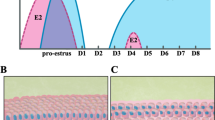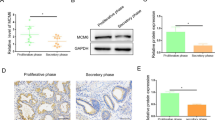Summary
Embryo implantation is a complicated physiological process tightly regulated by multiple biological molecules including growth factors. Transforming growth factor-betas (TGF-βs) and their most specific signal transduction factors, Smads, are expressed in the endometrium during the window of implantation. Recent researches indicated that Smad dependent TGF-β signaling may play an important role in the process of embryo implantation. In this study, we measured the expression of TGF-β1, TGF-β receptor type I (TβRI), Smad3 and p-Smad3 in the endometrium of mice and observed their elevation on day 4, 5 and 6 of pseudopregnancy. Then we administrated a specific Smad3 inhibitor (Sis3) into the uterine cavity of mice on day 3 of pregnancy. The results showed a reduction in insulin-like growth factor-1 (IGFBP-1) expression and the decreased number of implanted embryo after the administration. In addition, Sis3 was found to reduce the IGFBP-1 secretion in decidualized endometrial stromal cells. Taken all together, our findings demonstrated that TGF-β/Smad3 signaling is involved in the process of embryo implantation.
Similar content being viewed by others
References
Diedrich K, Fauser BC, Devroey P, et al. The role of the endometrium and embryo in human implantation. Hum Reprod Update, 2007,13(4):365–377
Achache H, Revel A. Endometrial receptivity markers, the journey to successful embryo implantation. Hum Reprod Update, 2006,12(6):731–746
Paria BC, Reese J, Das SK, et al. Deciphering the crosstalk of implantation: advances and challenges. Science, 2002,296(5576):2185–2188
Wang H, Dey SK. Roadmap to embryo implantation: clues from mouse models. Nat Rev Genet, 2006,7(3):185–199
Padua D, Massague J. Roles of TGFbeta in metastasis. Cell Res, 2009,19(1):89–102
Santibanez JF, Quintanilla M, Bernabeu C. TGF-beta/TGF-beta receptor system and its role in physiological and pathological conditions. Clin Sci, 2011,121(6):233–251
Massague J, Wotton D. Transcriptional control by the TGF-beta/Smad signaling system. EMBO J, 2000,19(8):1745–1754
Larsson J, Goumans MJ, Sjostrand LJ, et al. Abnormal angiogenesis but intact hematopoietic potential in TGF-beta type I receptor-deficient mice. EMBO J, 2001,20(7):1663–1673
Gaide Chevronnay HP, Cornet PB, Delvaux D, et al. Opposite regulation of transforming growth factors-beta2 and -beta3 expression in the human endometrium. Endocrinology, 2008,149(3):1015–1025
Omwandho CO, Konrad L, Halis G, et al. Role of TGF-betas in normal human endometrium and endometriosis. Hum Reprod, 2010,25(1):101–109
Stavreus-Evers A, Mandelin E, Koistinen R, et al. Glycodelin is present in pinopodes of receptive-phase human endometrium and is associated with down-regulation of progesterone receptor B. Fertil Steril, 2006,85(6):1803–1811
Peng J, Monsivais D, You R, et al. Uterine activin receptor-like kinase 5 is crucial for blastocyst implantation and placental development. P Natl Acad Sci USA, 2015,112(36):E5098–E5107
Heldin CH, Moustakas A. Role of Smads in TGFbeta signaling. Cell Tissue Res, 2012,347(1):21–36
Zhang Y, Feng XH, Derynck R. Smad3 and Smad4 cooperate with c-Jun/c-Fos to mediate TGF-beta-induced transcription. Nature, 1998,394(6696):909–913
Lin HY, Wang HM, Li QL, et al. Expression of Smad2 and Smad4, transforming growth factor-beta signal transducers in rat endometrium during the estrous cycle, pre-, and peri-implantation. Animal Reprod Sci, 2004,80(3–4):303–316
Zhao KQ, Lin HY, Zhu C, et al. Maternal Smad3 deficiency compromises decidualization in mice. J Cell Biochem, 2012,113(10):3266–3275
Maurya VK, Jha RK, Kumar V, et al. Transforming growth factor-beta 1 (TGF-B1) liberation from its latent complex during embryo implantation and its regulation by estradiol in mouse. Biol Reprod, 2013,89(4):84
Kim MR, Park DW, Lee JH, et al. Progesterone-dependent release of transforming growth factor-beta1 from epithelial cells enhances the endometrial decidualization by turning on the Smad signalling in stromal cells. Mol Hum Reprod, 2005,11(11):801–808
Godbole G, Suman P, Gupta SK, et al. Decidualized endometrial stromal cell derived factors promote trophoblast invasion. Fertil Steril, 2011,95(4):1278–1283
Matsumoto H. Molecular and cellular events during blastocyst implantation in the receptive uterus: clues from mouse models. J Reprod Develop, 2017,63(5):445–554
Munger JS, Sheppard D. Cross Talk among TGF-beta Signaling Pathways, Integrins, and the Extracellular Matrix. Csh Perspect Biol, 2011,3(11):a005017
Kaloglu C, Onarlioglu B. Extracellular matrix remodelling in rat endometrium during early pregnancy: The role of fibronectin and laminin. Tissue Cell, 2010,42(5):301–306
Anacker J, Segerer SE, Hagemann C, et al. Human decidua and invasive trophoblasts are rich sources of nearly all human matrix metalloproteinases. Mol Hum Reprod, 2011,17(10):637–652
Itoh H, Kishore AH, Lindqvist A, et al. Transforming growth factor beta1 (TGFbeta1) and progesterone regulate matrix metalloproteinases (MMP) in human endometrial stromal cells. J Clin Endocrinol Metab, 2012,97(6):E888–E897
Acknowledgement
We would like to thank Prof. Hans Rudolf Tinneberg and Dr. Lutz Konrad of the Department of Gynecology and Obstetrics, Justus Liebig University Giessen, Germany for providing us with the THESC cells.
Author information
Authors and Affiliations
Corresponding author
Additional information
Conflict of Interest Statement
The authors declare that they have no conflict of interest.
This work was supported by the National Natural Science Foundation of China (No. 81701450).
Rights and permissions
About this article
Cite this article
Li, J., Dong, Xy., Yang, Pw. et al. Activation of Uterine Smad3 Pathway Is Crucial for Embryo Implantation. CURR MED SCI 39, 997–1002 (2019). https://doi.org/10.1007/s11596-019-2134-z
Received:
Revised:
Published:
Issue Date:
DOI: https://doi.org/10.1007/s11596-019-2134-z




